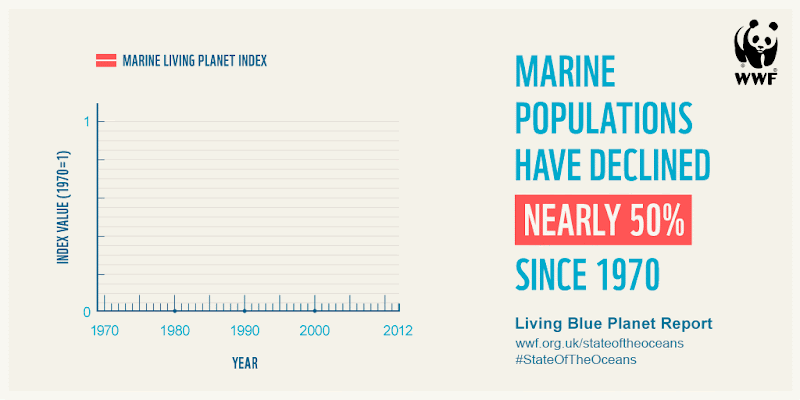Marine wildlife populations have declined by nearly half since 1970 – ‘If you are wondering whether it matters that life in the sea has gone down, the answer is yes. In the long term, it is a matter of life and death to all of us.’
By Callum Roberts
19 September 2015 (The Observer) – Sardines were once extraordinarily abundant in the south-west of England, leading one 19th-century guidebook to say: “Pursued by predaceous hordes of dogfish, hake and cod, and greedy flocks of seabirds, they advance towards the land in such amazing numbers as actually to impede the passage of vessels and to discolour the sea as far as the eye can reach … Of a sudden they will vanish from view and then again approach the coast in such compact order and overwhelming force that numbers will be pushed ashore by the moving hosts in the rear. In 1836 a shoal extended in a compact body from Fowey to the Land’s End, a distance of at least 100 miles if we take into consideration the windings of the shore.” (Handbook for Travellers in Devon and Cornwall, John Murray and Thomas Clifton Paris, 1851). Today people travel thousands of miles to dive and film such scenes, not realising they were once commonplace on our own coasts. Last week the World Wide Fund for Nature and the Zoological Society of London issued their most comprehensive look at the state of life in the sea. The report makes uncomfortable reading. Taking in more than 1,000 species worldwide and 5,000 populations of fish, turtles, marine mammals and a host of others, it draws the bleak conclusion that there is only half the amount of wildlife in the sea today as in 1970. Although 1970 is their baseline year and seems long ago, life in the sea has been in decline for much longer. In short, that means the picture is worse than the report suggests. And the waters around Britain demonstrate the same patterns that are slashing fish stocks around the world. The first well-documented herring fishery collapse around the UK was off East Anglia in the mid-1950s, followed by that in Scotland’s Firth of Clyde in the 1960s. An abundance of small fish attracted the attention of larger creatures, as the above passage shows. Fishermen found the great herring shoals by following the “signs” of those better able to search for them: seabirds raining attacks from the sky, blowing whales, leaping dolphins, the thrashing of thresher shark tails; there was always a frenzy somewhere along the coast. The seas of the early 19th century and before had an exuberance of life it is hard for us to comprehend today, so long has it been since anybody saw it. Huge fish also prowled the seabed. Common skate and halibut metres long and weighing 50kg or more were present in enormous numbers. Early photographs of fish markets around the UK show these fish covering the floor like great paving stones. Pictures of seaside towns show cod, ling, and hake each more than a metre long laid out for sale after being caught from small boats within a few miles of shore. There was a much greater diversity of large creatures in catches then. Animals such as wolffish, with their fabulous striped and spotted flanks, lurked in caves and rock piles. Conger eels were abundant too. Our cartoon view of the conger eel now is of a toothsome beast whose eyes twinkle from the portholes of sunken ships. The reason that wreck fishing is one of the most popular forms of sea angling is that these places are avoided by bottom trawlers, giving them de facto protection. Where trawling occurs, congers are scarce. It was bottom trawling that led to decline. Trawlers catch fish by dragging their nets over the seabed. It is not hard to imagine the damage this did to the great fields of invertebrates that lived on the bottom, including corals, sponges, seafans, sea nettles, oysters and hundreds of others. While big fish were the mainstay of net and hook-and-line fisheries from the middle ages to the early 19th century, they declined rapidly with the spread of trawling, especially when steam power was added in the 1880s and 90s. A recent analysis of catch records shows that the amount of fish caught by trawlers for every unit of power expended has declined 25 times from the 1860s to the present. The simple reason is because there is less life in the sea. [more]
Our seas are being degraded, fish are dying – but humanity is threatened too
